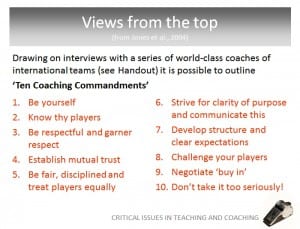It is fundamental to be able to have an active, understandable power relationship while coaching groups and individuals in sport (Jones, 2009: Piggot, 2012). Power is present in all social relationships and possessed by all individuals and social groups, arising out of their connections to each other (Gruneau, 1993). It reflects the ability to influence others to further interests and/or to resist the activities of others (Atlee and Atlee, 1992). Lyle (2002) notes the coach-athlete relationship is no exception and the exercise of power is an internal social issue.
“Managing interactions is key to social knowledge”
(Davey, 2008, p.43: Piggot, 2012)
Piggott (2012) indicates the importance of power relationships within coaching groups; involving the coaching commandments of Jones et al, 2009. These commandments associate with the 4 main coaching points: Behavior management, Communication, Differentiation and Planning.
(Piggott, 2012)
In order for the coaching to take place; the coach must be recognized as the authority figure (also known as specified person in their field). This will provide mental trust with the athletes – coach relationship, which in affect will increase respect and buy in to sessions/advise/competitions. It is important in the planning of sessions that the participant’s characteristics in physical and mental are known, as this will generate the correct challenges in the sport.
However this power can cause conflict if not used correctly. Coaches can use power both negatively and positively (Dodge and Roberston, 2004). Potrac et al (2002) found coaches were positive on the ratio of 33:1. This suggests that through time coaches have found negative use of power to have less or a detrimental on athlete performance.
A prime example of how a coach uses power is evident in the insertion of new exercise into a current training program. A coach could use solely legitimate power to encourage athletes to try new exercises, since the role of the coach demands respect. This is could be followed and enforced by a rewarding (reward power) the athlete with a shorter session. Alternatively the athlete could be forced to partake or face a punishment of 50 press-ups. The coach could tell the athlete that these exercises were what made him/her a world champion (referent power) and inform them of previous successes of other athletes who use the same method (expert). A negative use of power could involve making one particular athlete of the whole team clear up after other group members. ‘The challenge to the coach is to recognize the power and learn how to use it rationally with discretion.’ Kinsman (1999)
To conclude this it is important to provide a balance in coaching, aka: don’t take it too seriously!

